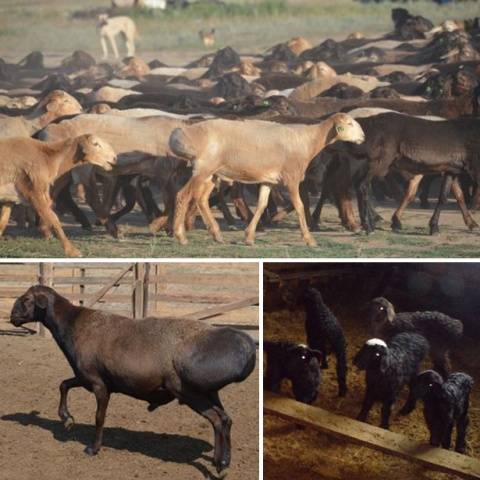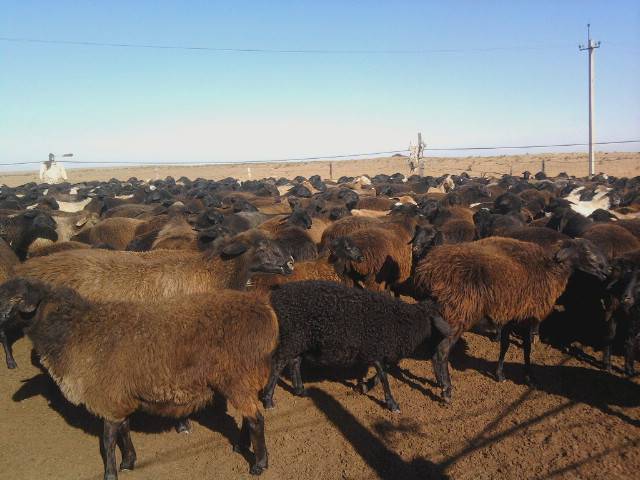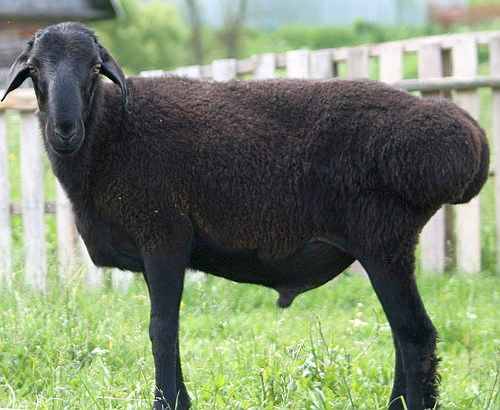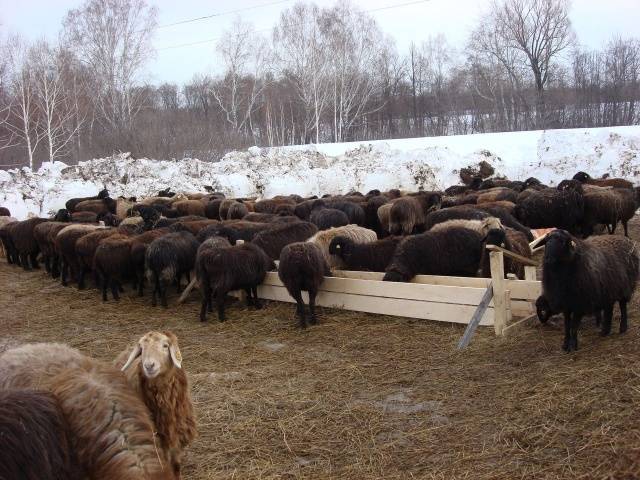Content
Since ancient times, in the region of Central Asia, it has been practiced sheep breeding meat and greasy direction. Lamb fat is considered a valuable product among the Central Asian peoples. Along the way, wool is obtained from these coarse-wooled sheep for felting.
One of the most common breeds of fat-tailed meat and fat breeds are Edilbaevskie sheep.
The homeland of this breed is Kazakhstan. The standard stereotype of a resident of the European part of Russia in relation to Kazakhstan: a very hot country. In fact, this is not at all the case. Kazakhstan is located in the center of the mainland and has a sharply continental climate, that is, hot summers and cold winters.
For life in such conditions, the Edilbaev breed of sheep was bred. Sheep store fat in the back of the body, the so-called "fat tail", which is why they got the name "fat tail". The Edilbaevites fatten up quickly, since in summer the Kazakh steppe burns out and there is nothing to eat in it. Since the summers are hot, the fat evenly distributed throughout the body would cause the sheep to overheat. Animals unable to "put fat separately" in the summer usually lose weight.
The weight of a fat tail in the Edilbaev breed can reach 15 kg. Thanks to such reserves of fat, Edilbaevskaya sheep perfectly tolerate both summer with dried grass and cold winters. Edilbaevtsy are animals adapted to nomadic life and able to travel long distances in search of food.
The Edilbaevskaya breed is, in fact, a lifesaver for the Kazakhs, since, in addition to lamb fat, you can get sufficiently high-quality meat and sheep's milk from the Edilbaevskaya sheep.
Productive characteristics
The weight of an adult Edilbaevsky ram can reach 145 kg, and ewes up to 110 kg. The Edilbaevites are inferior in size to the Hissar sheep, about which there is a constant dispute. Some believe that the Edilbaevskaya breed is actually the Hissar breed. If you look at the map, the conclusion suggests itself: these breeds are related to each other. The boundaries between the former republics, and now states, in many places were clearly drawn along a line. The number of local animals probably mixed with each other.
Edilbaevskaya breed at the All-Russian Sheep Exhibition in Elista
Edilbaevtsy belong to the coarse-wooled breed of sheep, from them you can get 3-4 kg of wool per year. Coarse wool sheep should be sheared once a year in the spring. As a source of wool, the Edilbaevskaya breed of sheep has no special value.
As a breed of nomads, Edilbaevs are valuable for their endurance and versatility. In addition to meat and fat, up to 120 liters of milk with a fat content of 6 - 8% can be obtained from the Edilbaevskaya ewes. The milk of the Edilbaevites is suitable for the manufacture of sour milk products, as well as cheese and butter. In the traditions of the Central Asian peoples, it is from sheep's milk, not cow's milk, to make cheeses. And the Edilbaev breed was bred with an eye to a high milk yield for sheep.
The breed is distinguished by its early maturity. By the age of 4 months, the weight of Edilbaev's lambs reaches 40 - 45 kg. At this age, lambs can already be slaughtered for meat.
The fertility of Edilbaev's sheep is low. Usually only one lamb is born. The period of maturity in sheep is 5 months, so it will not be possible to squeeze out more than two lambing per year from a sheep.
In the photo Edilbaevskaya ewes with a lamb.
The body of the ewe must have time to recover after the birth of the lamb.
Edilbaevskaya breed standard
Edilbaevtsy are strong, hardy animals with relatively long legs, outstanding adaptability to long transitions. Height at the withers is from 80 cm. The fat tail is well developed and, in normal condition, stands out clearly on the rump of a sheep.
The color of the Edilbaevs is usually monochromatic. The color can be black, red or brown.
The Edilbaevites have no horns, their ears are drooping.
Content
At home, this breed is kept on open pastures almost all year round. Thanks to the fat tail, the Edilbaevites are able to withstand not too protracted jute. Thanks to their endurance, unpretentiousness and high productive characteristics, they began to breed Edilbaevites in Russia. And here the ability of animals to constantly live in the open air played a cruel joke with the Edilbaevites.
The weak point of these sheep is the hooves. In the absence of constant transitions and keeping in the same enclosure, the hoof horn begins to deteriorate. Sheep somehow breed mud and dampness, and hooves are adapted to dry ground. In a normal nomadic life, sheep's hooves grind against rocky ground, when kept in a pen, the hoof wall grows back and begins to interfere with the animals. The sheep start to limp.
When kept in dampness, the hooves get infected with a fungus that causes hoof rot, which is very difficult to get rid of, since the main medicine in this case is constant movement so that the hooves are properly supplied with blood. Antifungal agents are ineffective, the fungus reappears.
Thus, Edilbaevites need a dry, clean room to avoid hoof diseases.
To avoid stirring the clay, a thick layer of bedding should be laid on the adobe floor, but the floors will still need to be repaired every year.
On the concrete or asphalt floor, it is also necessary to lay a litter abundantly, since on the bare stone the Edilbaevites are cold and sick, but such floors are durable.
At first glance, the recommendations to keep the Edilbaevites on wooden flooring seem reasonable, but urine flows into the cracks between the boards, and anyone can easily find the house where the sheep are kept by the smell. In addition, ammonia fumes are extremely harmful to a breed bred for year-round outdoor maintenance.
The best option is rubber mats for livestock, allowing you to save bedding, warm enough and easy to clean. Unfortunately, they are expensive, albeit durable.
The sheep shed should not be too warm. It must reliably protect against drafts and have good ventilation. Most animals are not afraid of the cold. With a sufficient amount of food, they are warmed up with food. Animals will heat the air in the room by breathing. Large temperature differences between indoor and outdoor leads to respiratory diseases.
This is explained by the fact that the lamb is born wet and may die from hypothermia before it dries out.
Feeding the Edilbaevites
Edilbaevskaya breed has the ability to quickly fatten on green grass, while this grass is still not dry. In the spring-summer season, sheep need to add salt to the diet if the flock does not graze on salt licks.
In summer, Edilbaevites can eat off on the grass, not needing other food. In winter, in addition to hay, concentrates are added to the sheep ration at the rate of 200 - 400 g per head per day. In addition, feed chalk and vitamin and mineral premixes are added to the diet.
Many sheep breeders believe that sheep do not need water in winter, they can "get drunk" with snow. This is fundamentally a misconception, since snow is distilled water without mineral salts necessary for the body. Snow not only does not meet the needs of animals for minerals, but also flushes trace elements and minerals from the body. The best option in winter is to install heated drinkers. You can use the thermos principle if it is not possible to equip heating. But in this case, you will often have to add hot water to the drinking bowl.
Breeding
In fact, one of the advantages of the Edilbaev breed is their infertility. Bringing one, maximum two, lambs per lamb, the ewes have the opportunity to feed strong strong offspring. Edilbaevskie ewes are distinguished by high milk yield. If a person does not take sheep's milk for his needs, it all goes to the lamb, which by 4 months is often larger than other breeds of sheep.
Measuring and weighing 3-4 month old Edilbaevskiy rams
By the time of mating, ewes should come up fattened, since with insufficient fatness, the number of barn ewes increases by 4 - 5 times. And here the fat tail of the Edilbaev breed plays into the hands of the owners. Even in the event of force majeure, the Edilbaevskaya ewe is more likely to successfully inseminate than a sheep that does not have fat reserves.
If you want to get a lamb in the spring, ewes should be done with rams in the middle of autumn. If winter lambing is planned, then the sheep are launched into the flock in the summer.
In the first half of pregnancy, the needs of the ewes do not differ from those of the barny sheep. The ewes are given plenty of green grass or hay, 200 g of concentrates per day and 10 g of table salt.
But if it is possible to give compound feed for sheep, it is better to give it, thus reducing the deficiency of vitamins and minerals.
In the second half of pregnancy, the need for nutrients and energy increases in ewes. If the second half of the pregnancy occurs in winter, it is necessary to carefully monitor the presence of minerals and vitamins in the diet of the ewes.
With inadequate feeding of the ewe, the viability of the embryo decreases.
The finished sheep is placed separately from the rest of the flock. The air temperature during lambing should not be lower than + 10 ° С. Fresh straw is spread on the floor in a thick layer. After lambing, the lamb is thoroughly wiped off and offered to the sheep. It is imperative to check the placenta. It should be whole. If pieces of the placenta are missing, you need to monitor the condition of the sheep for a couple of days. You may need the help of a veterinarian.
Diet of a lactating ewe
For the first 2 - 3 days, the deformed ewes are kept only on high-quality bean hay to avoid the development of mastitis. Later, concentrates are slowly introduced, bringing their amount to half a kilogram per day. After 1 - 1.5 weeks, succulent feed is gradually added to the ewes' diet, bringing their amount to 2 kg, and high-quality silage is also in the amount of 2 kg per day.
The need for high-quality hay is also 2 kg. Thus, in total, the ewes receive 6.5 kg of feed per day.
The diet requires salt and vitamin and mineral supplements.
Owner reviews
Conclusion
Taking into account the fact that sheep breeding in Russia was more focused on obtaining wool from sheep, meat and meat-greasy Russian breeds are practically absent. With a bit of a stretch, the Karakul breed can be called meat, but it was also bred for the sake of the karakul skin. The Edilbaevskaya breed is quite capable of filling the empty niche of sheep meat breeds. The Edilbaevites are inferior only to the Hissar breed, which is considered the largest in the world. But there are no Gissarians in Russia, and Edilbaevskys are already being bred not only by large farms, but also by private traders. It is much easier to buy Edilbaevskaya breed.
















